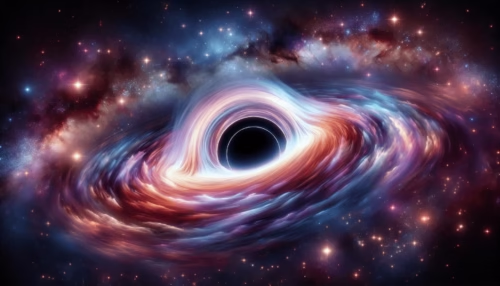Have you ever wondered what happens at the edge of a black hole? The mysteries surrounding black holes have captivated both scientists and the public for decades, serving as focal points for debates and theoretical explorations in the realms of astrophysics and cosmology. Understanding black holes is not merely an academic exercise; it offers profound insights into the very structure of space-time itself.
Table of Contents
Overview
Black holes are enigmatic entities where gravity is so strong that nothing, not even light, can escape. This characteristic alone has fascinated researchers, leading to deeper investigations into their nature. In this article, we will explore the profound mysteries of black holes, unravel their complexities, and discuss their implications on our understanding of the universe.
Thesis Statement
Black holes symbolize the ultimate frontier of our understanding of the universe, standing as crucial tests for our theories of space and time. As we delve into their secrets, we not only fuel our curiosity but also expand our grasp of the fundamental laws that govern the cosmos.
Rationale
Historical Context
The concept of black holes can be traced back to the 18th century when British natural philosopher John Michell first speculated about “dark stars” having gravitational pulls so strong that they could trap light. However, the modern understanding of black holes began with Einstein’s General Theory of Relativity in 1915, which predicted the existence of such objects as solutions to his field equations. Since then, black holes have progressed from theoretical curiosities to accepted constituents of our universe, based on both theoretical advances and astronomical evidence.
Current Trends
In recent years, black holes have become even more relevant due to groundbreaking observations and technological advances. The first-ever photograph of a black hole’s event horizon, made possible by the Event Horizon Telescope in 2019, offered tangible evidence of these elusive phenomena. Furthermore, the detection of gravitational waves, ripples in space-time caused by merging black holes, has opened a new window for studying cosmic events. These developments have made black holes pivotal in the pursuit of a unified theory in physics, challenging our understanding of gravity, space, and time.

Main Content
Key Concepts and Definitions
To understand black holes, it is important to familiarize oneself with some fundamental terms:
- Event Horizon: The boundary around a black hole beyond which no information or matter can escape.
- Singularity: A point within a black hole where density becomes infinite, and the laws of physics as we know them cease to function.
- Schwarzschild Radius: The radius of a sphere such that if all the mass of an object were to be compressed within that sphere, the escape velocity from the surface would equal the speed of light.
Understanding Black Hole Mechanics
A black hole is formed when a massive star collapses under its own gravity. According to Einstein’s equations, this collapse continues until a singularity forms, surrounded by an event horizon. Within this boundary, all conventional laws of physics break down, leading to questions and exploration about the ultimate nature of reality.
Example 1: Stellar-Mass Black Holes
Stellar-mass black holes are formed from the remnants of massive stars. When a star exhausts its nuclear fuel, its core collapses under gravity, potentially forming a black hole if the mass is sufficient. Observations of X-ray emissions from binary star systems where a presumed black hole is accreting matter from a companion star provide strong evidence for their existence.
Example 2: Supermassive Black Holes
Found at the centers of most galaxies, including our own Milky Way, supermassive black holes contain millions to billions of times the mass of the Sun. Their formation is still a subject of research. However, they are believed to have formed in the early universe and have grown over time by accreting matter and merging with other black holes.
Comparing Different Points of View
While Einstein’s general relativity describes black holes well on a macroscopic scale, it ultimately breaks down at the singularity, where quantum effects cannot be ignored. This tension between theories of relativity and quantum mechanics is one of the most challenging problems in theoretical physics, motivating the search for a theory of quantum gravity.
Comparison Table: Physical Theories in Understanding Black Holes
| Aspect | General Relativity | Quantum Mechanics | Classical Physics |
|---|---|---|---|
| Scale | Macroscopic | Microscopic | Macroscopic |
| Gravitational Effects | Describes gravity well | Incomplete description | Simplifies or ignores |
| Role of Time | Continuous, relative | Probabilistic, discrete | Absolute and continuous |
| Application to Black Holes | Defines event horizon, etc. | Uncertain in singularities | Limited pre-relativity |
Impact Assessment
The study of black holes has profound implications for various fields. They challenge the boundaries of what we understand about gravity and quantum physics and compel scientists to reconcile discrepancies between the two. Black holes also shed light on the processes that control galaxy formation and evolution, providing clues about the early universe.

Future Directions and Implications
Predictions
The future of black hole research is promising with potential breakthroughs on the horizon. Quantum simulations and advanced observatories may unravel mysteries surrounding event horizons and singularities. One promising direction is the study of “Hawking radiation,” a theoretical prediction suggesting black holes emit radiation and may eventually evaporate over time. Continued exploration may lead to a more unified theory incorporating both quantum mechanics and general relativity.
Implications
Understanding black holes could one day revolutionize technology and philosophy alike. They serve as cosmic laboratories where researchers can test our most advanced theories. These investigations may lead to new insights about the universe’s birth in the Big Bang, the nature of time, and maybe even resolve paradoxes about the nature of information itself.

Conclusion
To summarize, black holes challenge our understanding of the universe at the most fundamental level. They exist at the intersection of the known and the unknown, prompting profound questions about the laws that govern space-time and matter. As research continues to expand our understanding, we are likely to uncover more surprises and insights. What do you think will be the most exciting discovery in the study of black holes in the coming years?
By examining these cosmic enigmas, you engage in a journey to the very limits of human understanding, a quest that not only answers questions but also piques your curiosity about the nature of reality itself. As you ponder these mysteries, consider digging deeper into related topics, such as the intersection of quantum mechanics and gravitational theory, for a fuller understanding of the cosmos.


